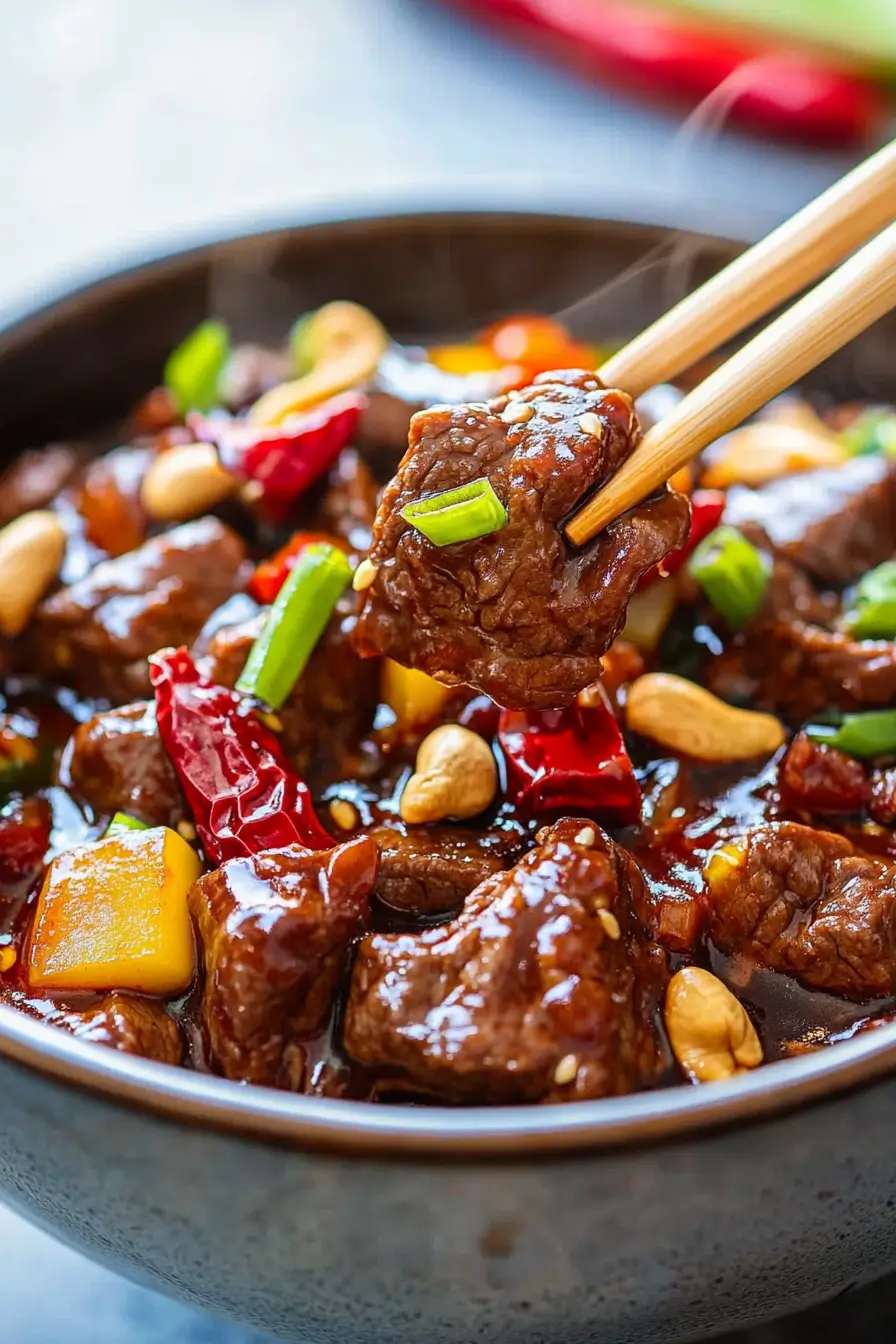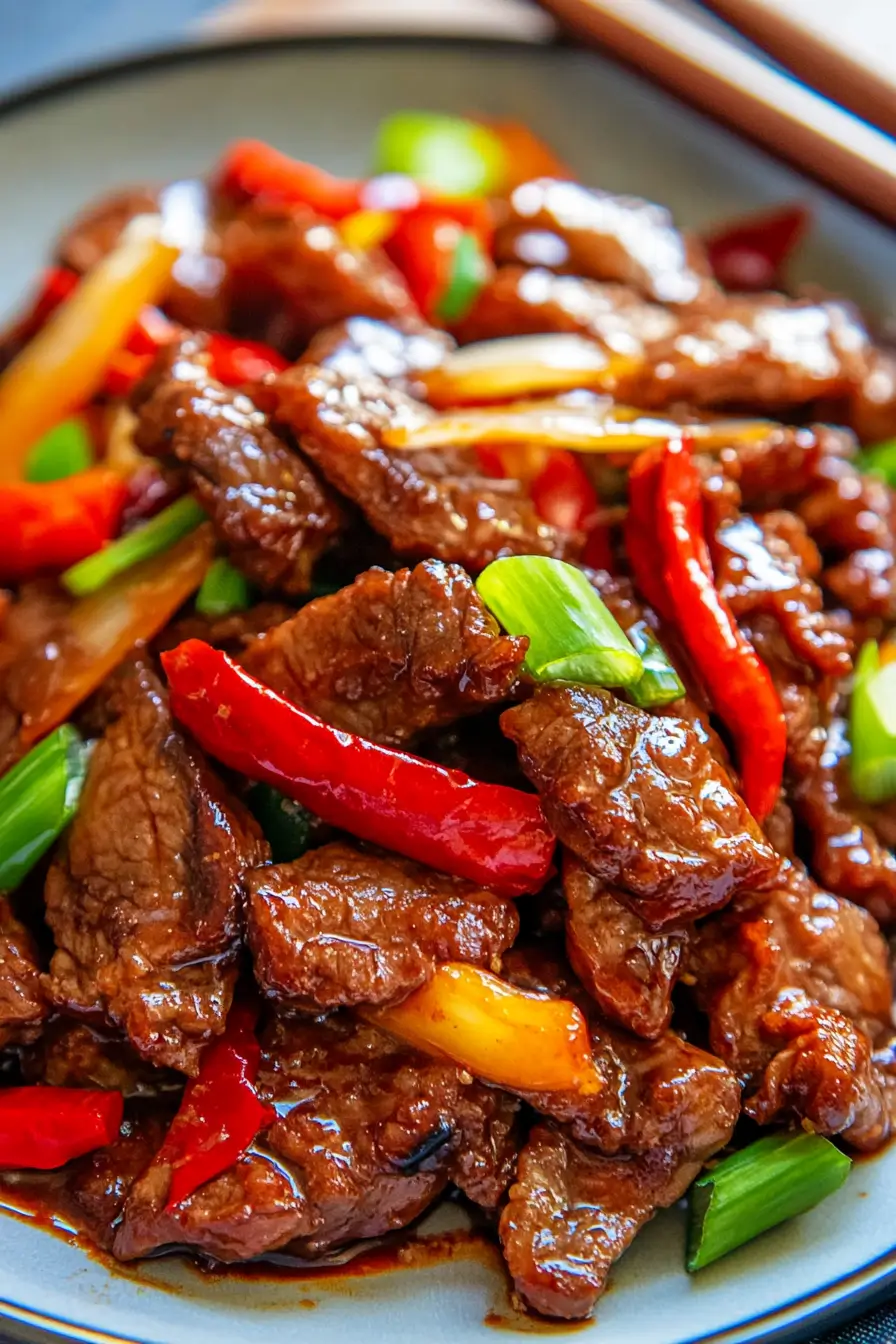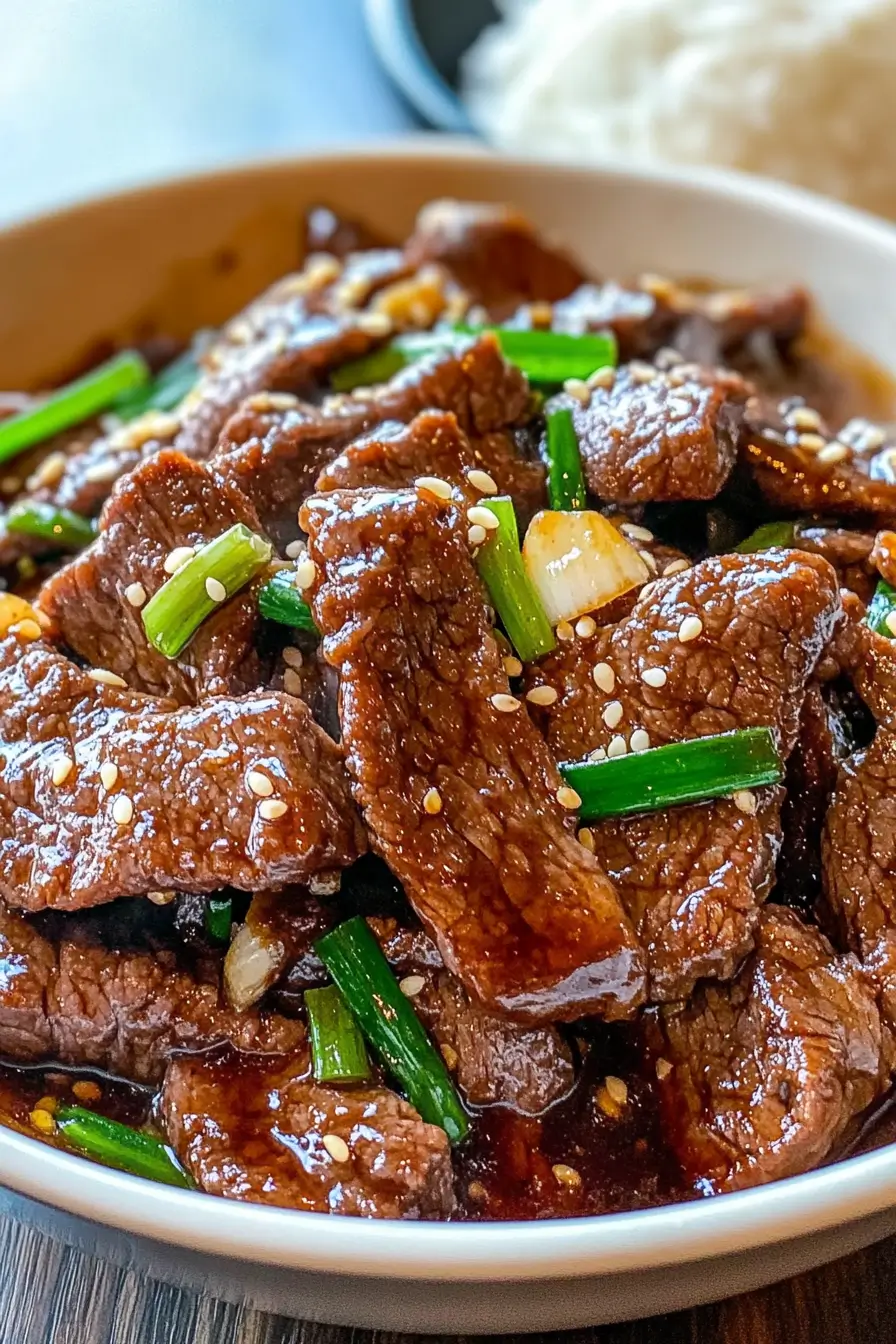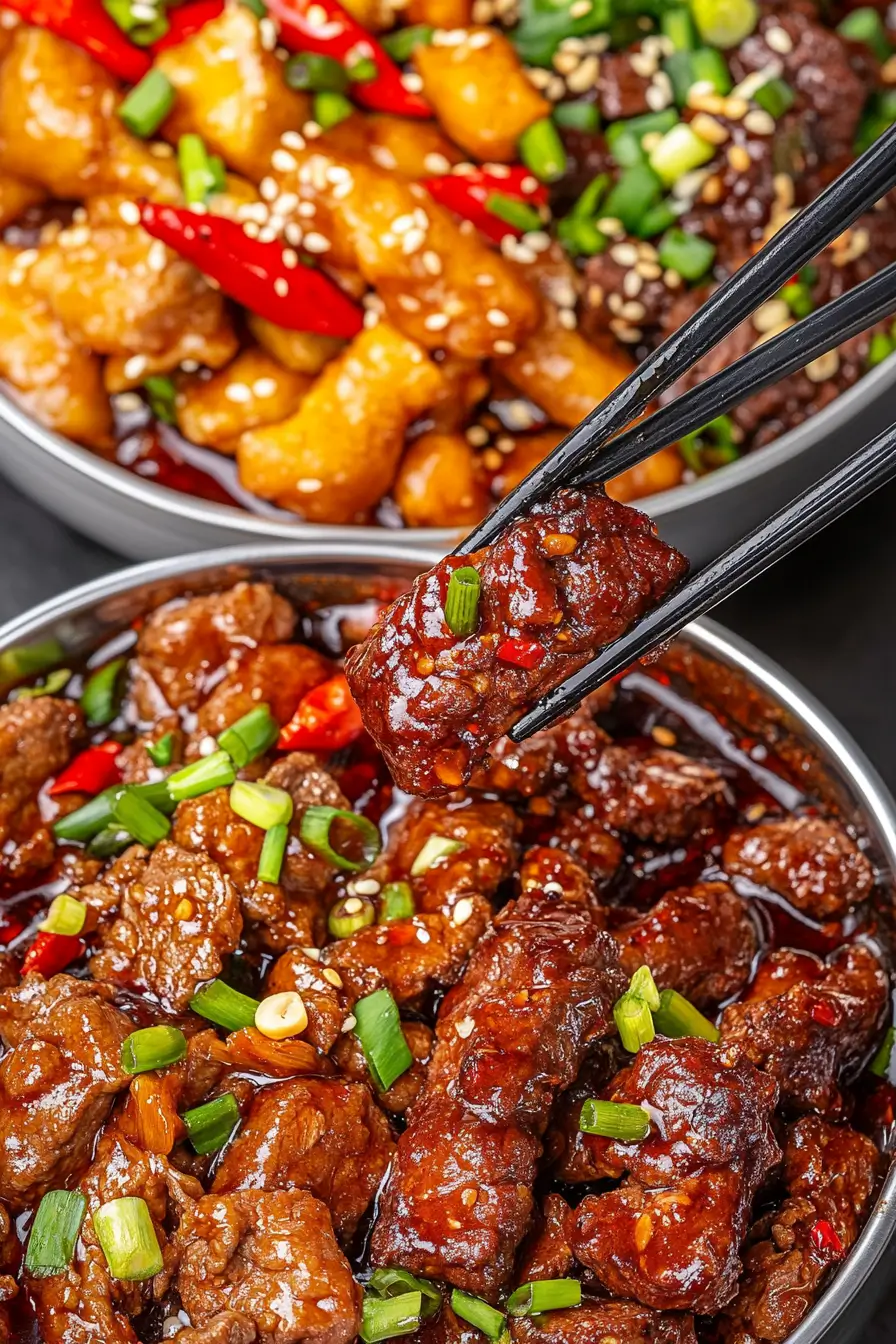I’m so excited to share these three incredible Asian beef stir fry recipes with you today! There’s something magical about the sizzle of thinly sliced beef hitting a hot wok, the aromatic cloud of ginger and garlic rising to greet you, and that perfect balance of sweet, savory, and spicy flavors that makes Asian stir-fries absolutely irresistible. These three beef stir-fry recipes—Kung Pao Beef, Crispy Chili Beef, and Mongolian Beef—represent the absolute best of Asian cuisine that you can easily recreate in your own kitchen. Each dish brings its own unique personality to the table while sharing that addictive umami-rich profile we all crave from Asian cooking. I’ve tested these recipes countless times, perfecting each component until they rival anything you’d find at your favorite restaurant, and I can’t wait for you to experience them!
Why You’ll Love These Asian Beef Stir Fry Recipes
These three Asian beef stir fry recipes are about to become your new weeknight heroes! Not only are they incredibly flavorful, but they’re also surprisingly quick to prepare once you’ve got your ingredients lined up. The beauty of these dishes lies in their perfect balance of textures and flavors—tender beef with crispy edges, vibrant vegetables, and sauces that hit every note from sweet to savory to spicy.
What makes these recipes truly special is their versatility. Having a bad day? The fiery kick of Crispy Chili Beef will wake up your taste buds and your spirits. Cooking for someone special? The elegant balance of Mongolian Beef feels restaurant-worthy without requiring professional skills. Need to please picky eaters? The familiar yet exciting flavors of Kung Pao Beef, with its crunchy peanuts and colorful vegetables, wins over even the most hesitant diners.
Each recipe is designed to be approachable even for beginners, with straightforward techniques that yield impressive results. And unlike takeout, you control the ingredients—adjust the spice level, reduce the sugar, or amp up the vegetables to suit your preferences and dietary needs. I promise once you master these three spectacular beef stir-fries, you’ll find yourself reaching for your wok instead of the takeout menu!
Ingredients for Asian Beef Stir Fry Recipes
1. Kung Pao Beef

- 1 lb flank steak or sirloin, thinly sliced against the grain
- 1 tablespoon soy sauce (for marinade)
- 1 tablespoon Shaoxing wine
- 1 teaspoon cornstarch (for marinade)
- 1 teaspoon sesame oil
- 2 tablespoons vegetable oil
- 8-10 dried red chilies
- 3 cloves garlic, minced
- 1-inch piece of ginger, minced
- 1 red bell pepper, sliced
- Half yellow onion, sliced
- 1/4 cup roasted peanuts
- 2 green onions, chopped
- 2 tablespoons soy sauce (for sauce)
- 1 tablespoon dark soy sauce
- 1 tablespoon rice vinegar
- 1 tablespoon hoisin sauce
- 1 tablespoon sugar
- 1/4 cup water
- 1 teaspoon cornstarch (for sauce)
2. Crispy Chili Beef

- 1 lb flank steak or sirloin, thinly sliced
- 2 tablespoons soy sauce (for marinade)
- 1/2 tablespoon sesame oil
- 1 garlic clove, finely grated
- 1/2 cup cornstarch
- 1 red bell pepper, sliced
- 1 red chili, sliced
- 2 cloves garlic, minced
- 1-inch piece of ginger, minced
- 1 red chili, finely chopped
- Half white onion, sliced
- 2 stalks green onion, sliced
- Oil for frying
- 2 tablespoons soy sauce (for sauce)
- 1 tablespoon rice vinegar
- 1/4 cup sweet chili sauce
- 2 tablespoons honey
- 1 tablespoon Chinese Shaoxing wine
3. Mongolian Beef

- 2 lbs flank or sirloin steak
- 1 tablespoon baking soda
- 2 tablespoons cornstarch
- 1 teaspoon kosher salt
- 2 tablespoons olive oil
- 2 teaspoons soy sauce
- 1 teaspoon mirin
- 2 tablespoons oyster sauce
- 1 tablespoon hoisin sauce
- 2 tablespoons soy sauce (for sauce)
- 2 tablespoons brown sugar
- 6 cloves of garlic, minced
- 2 teaspoons minced ginger
- Green onions for garnish
- Sesame seeds for garnish
- 1/4 cup vegetable oil for frying
Necessary Tools
Having the right equipment on hand will make preparing these Asian beef stir fries much easier and more enjoyable. Here’s what you’ll need:
- A good wok or large skillet – The wide surface area and high sides of a wok are ideal for stir-frying, but a large skillet will work as well. Look for one that heats evenly and retains heat well.
- Sharp knife – A sharp chef’s knife is essential for slicing beef thinly against the grain. This cut is crucial for tender beef in stir-fries.
- Cutting board – Preferably one designated for meat and another for vegetables to prevent cross-contamination.
- Small bowls – Several small bowls for your pre-measured ingredients will make the cooking process smoother. Stir-fries cook quickly, so having everything ready is key.
- Measuring spoons and cups – For precise sauce measurements that ensure balanced flavors.
- Wooden spoon or wok spatula – Something sturdy that can handle high-heat cooking and won’t scratch your cookware.
- Meat thermometer (optional) – While traditional stir-fries typically cook beef well done, if you prefer your beef medium-rare, a meat thermometer can help achieve the perfect temperature.
- Rice cooker (optional) – Not strictly necessary, but convenient for preparing perfect steamed rice to accompany your stir-fries.
Ingredient Additions & Substitutions for Asian beef stir fry recipes
One of the greatest things about these Asian beef stir fry recipes is how adaptable they are. Here are some substitutions and additions to help you make these recipes work with what you have on hand or to accommodate dietary restrictions:
Protein Substitutions
- Chicken: Substitute chicken breast or thighs cut into thin strips for the beef in any of these recipes. Adjust cooking time as chicken cooks more quickly than beef.
- Tofu: For a vegetarian version, use extra-firm tofu. Press it well to remove excess moisture, then cut into cubes. For Crispy Chili “Beef,” bread the tofu in cornstarch and fry until crispy.
- Shrimp: Large shrimp work beautifully in these recipes, particularly in the Kung Pao recipe. They cook even faster than beef, so add them toward the end of the cooking process.
Sauce Adaptations
- Gluten-Free: Replace soy sauce with tamari or coconut aminos. Check that your hoisin and oyster sauces are gluten-free, or make your own gluten-free versions.
- Less Sugar: Reduce the sugar in the Mongolian Beef or replace with a natural sweetener like coconut sugar or a small amount of maple syrup.
- Lower Sodium: Use low-sodium soy sauce and reduce the amount by half, adding a splash of water to maintain volume.
Vegetable Options
- Add broccoli florets to any of these recipes for extra nutrition and volume.
- Snow peas or sugar snap peas add a delightful crunch to Mongolian Beef.
- Try adding thinly sliced carrots to Kung Pao Beef for color and natural sweetness.
- Water chestnuts bring an incredible texture to any of these dishes.
- Baby corn is a fun addition that adds visual appeal and a sweet flavor.
Spice Level Adjustments
- For milder versions, reduce the amount of dried chilies or fresh chilies.
- To increase heat, add a teaspoon of chili oil or a sprinkle of red pepper flakes.
- If you can’t find Chinese dried chilies, substitute with dried arbol chilies or even a pinch of cayenne pepper.
Wine Substitutions
- If you don’t have Shaoxing wine, dry sherry is the best substitute.
- For an alcohol-free version, use chicken broth with a splash of rice vinegar.
Remember, stir-fries are forgiving dishes that welcome experimentation. Don’t be afraid to make these recipes your own by adjusting flavors and ingredients to suit your taste!
Serving Suggestions
These three Asian beef stir fry dishes are incredible on their own, but pairing them with the right sides elevates the entire dining experience. Here are some perfect companions for each recipe:
For Kung Pao Beef, the bold and spicy flavors call for simple, neutral sides that won’t compete with its complexity. Steamed jasmine rice is the classic choice, but for something different, try serving it with coconut rice – the subtle sweetness beautifully balances the heat of the dish. For a complete meal, add simple steamed or stir-fried bok choy on the side, dressed with just a touch of sesame oil and salt.
Crispy Chili Beef pairs wonderfully with thin egg noodles tossed in a little sesame oil. The crispy texture of the beef contrasts beautifully with the soft noodles. For a refreshing counterpoint to the rich, sweet-spicy sauce, serve a cucumber salad on the side – just slice cucumbers thinly, toss with rice vinegar, a pinch of sugar, and a sprinkle of sesame seeds. The cool crunch provides the perfect balance to the heat.
Mongolian Beef’s rich, savory-sweet profile is traditionally served with steamed rice, but for a twist, try it with fried rice studded with egg and green peas. The dish also pairs beautifully with steamed broccoli or Chinese broccoli (gai lan) with oyster sauce. For presentation, serve your Mongolian Beef on a bed of crispy fried rice noodles for an impressive textural contrast.
For all three dishes, consider offering small bowls of additional condiments like chili oil, sliced fresh chilies in vinegar, or extra roasted peanuts so guests can customize their meal. A refreshing beverage like iced jasmine tea, a light lager beer, or a semi-dry Riesling wine complements these flavorful dishes perfectly, helping to cleanse the palate between bites of these intensely flavored beef stir-fries.
Pro Tips & Tricks to make Asian beef stir fry recipes
Take your Asian beef stir fries from good to restaurant-quality with these professional tips and techniques that make all the difference:
Freeze the beef for 20 minutes before slicing.
This firms it up just enough to make cutting thin, even slices much easier. Always remember to slice against the grain for maximum tenderness.
Don’t skip the marinade time.
Even a quick 15-minute marinade drastically improves both flavor and texture. The cornstarch in the marinades not only tenderizes but also creates a protective coating that keeps the meat juicy during high-heat cooking.
Dry your beef thoroughly before frying.
Especially for the Crispy Chili Beef, excess moisture is the enemy of crispiness. Pat the marinated meat dry with paper towels before dredging in cornstarch.
Get your wok smoking hot before adding oil.
This prevents sticking and enables proper searing. When you add oil to a properly heated wok, it should spread quickly and shimmer immediately.
Cook in batches if necessary.
Overcrowding the pan causes steaming instead of searing. It’s worth the extra few minutes to cook in batches for that perfect texture.
Have everything prepped before you start cooking.
Stir-fries move quickly! Having all ingredients measured, chopped, and within arm’s reach (what chefs call “mise en place”) ensures smooth cooking and properly cooked ingredients.
Toast your dried chilies and Sichuan peppercorns.
For Kung Pao Beef, briefly toasting the dried chilies in dry heat before adding oil releases their aromatic oils and deepens their flavor.
The baking soda trick for Mongolian Beef.
The brief alkaline treatment from baking soda breaks down the meat proteins, creating that signature “velvety” texture famous in Chinese restaurants. Don’t use more than recommended or leave it on too long, or it can affect the flavor.
Balance is key in the sauces.
Always taste your sauce mixtures before adding them to the wok. You should detect sweet, salty, sour, and umami in harmonious proportions. Adjust as needed.
Watch the heat when adding garlic and ginger.
These aromatics burn easily and turn bitter. Add them to moderate heat or briefly remove the wok from the flame when adding them.
For the crispiest beef in the Crispy Chili Beef recipe,
add the sauce at the very last minute and toss quickly to preserve the texture. The sauce should coat the beef but not soak into it.
Don’t be afraid of caramelization.
Those dark, flavorful bits that stick to the pan (what chefs call “fond”) contain concentrated flavor. Deglaze with your sauce to incorporate all that goodness.
How to Store Asian beef stir fry recipes
Properly storing your leftover Asian beef stir fries ensures they remain delicious for days after cooking. Here’s how to store, reheat, and even freeze these dishes:
Refrigerator Storage
For short-term storage, allow your stir-fry to cool completely before transferring to airtight containers. Store in the refrigerator for 3-4 days. I recommend storing the rice or noodles separately from the stir-fry whenever possible, as they have different ideal storage conditions and reheat times.
Reheating Kung Pao and Mongolian Beef
When reheating Kung Pao Beef or Mongolian Beef, the stovetop method yields the best results. Add a tablespoon of water or chicken broth to a skillet over medium heat, then add your refrigerated stir-fry and toss gently until heated through (about 3-5 minutes). This prevents the beef from becoming tough and revitalizes the sauce.
Reheating Crispy Chili Beef
For Crispy Chili Beef, the microwave will make the beef soggy, so reheating in a 350°F oven for 5-7 minutes is your best bet to maintain some crispiness. You can also briefly re-fry the beef pieces in hot oil before tossing with the reheated sauce and vegetables.
Freezing Instructions
If you’re planning to freeze these dishes, Kung Pao Beef and Mongolian Beef freeze reasonably well for up to 2 months. Store in freezer-safe containers with as little air as possible. I don’t recommend freezing Crispy Chili Beef, as the texture will be compromised upon thawing. When freezing, consider portioning into meal-sized amounts for easier defrosting.
Reheating from Frozen
To reheat from frozen, thaw overnight in the refrigerator, then follow the stovetop reheating method above. You may need to add a little extra sauce or broth as frozen and thawed dishes can sometimes become dry.
Make-Ahead Tips
For make-ahead meal prep, consider preparing components separately: marinate and cook the beef, prepare the vegetables and sauce, but store them separately. Combine and finish cooking just before serving for the freshest results. The beef marinades can also be prepped 1-2 days in advance and stored in the refrigerator until you’re ready to cook.
General Information
Kung Pao Beef
- Preparation Time: 20 minutes
- Cooking Time: 10 minutes
- Total Time: 30 minutes
- Servings: 4
- Calories per Serving: Approximately 320 calories
- Difficulty Level: Medium
- Spice Level: Medium-High
- Origin: Sichuan Province, China
Crispy Chili Beef
- Preparation Time: 15 minutes (plus 10 minutes marinating)
- Cooking Time: 15 minutes
- Total Time: 40 minutes
- Servings: 4
- Calories per Serving: Approximately 390 calories
- Difficulty Level: Medium
- Spice Level: Medium (adjustable)
- Origin: Western Chinese-inspired dish popular in UK Chinese restaurants
Mongolian Beef
- Preparation Time: 15 minutes (plus 1 hour or overnight marinating)
- Cooking Time: 15 minutes
- Total Time: 1 hour 30 minutes (including minimum marination)
- Servings: 6
- Calories per Serving: Approximately 350 calories
- Difficulty Level: Easy
- Spice Level: Mild
- Origin: Chinese-American cuisine, despite the name not actually Mongolian
These beef stir-fry recipes are excellent examples of how Asian cuisine balances flavors and textures to create memorable dishes. While they all feature beef as the star ingredient, each has its own distinctive character: Kung Pao brings heat and numbing spice from Sichuan traditions, Crispy Chili Beef showcases textural contrast with its crispy exterior and sticky sauce, and Mongolian Beef offers a more approachable, sweet-savory profile that’s become a staple in Chinese-American restaurants.
FAQs
Q: What’s the best cut of beef to use for stir-fries?
A: Flank steak and sirloin are ideal for stir-fries as they have good flavor and remain tender when sliced thinly against the grain. Skirt steak, flat iron steak, and ribeye also work well. Avoid cuts like chuck or brisket, which require long cooking times to become tender.
Q: I can’t find Shaoxing wine. What can I substitute?
A: Dry sherry is the best substitute for Shaoxing wine. Other alternatives include mirin (using slightly less as it’s sweeter), dry white wine with a pinch of sugar, or for a non-alcoholic version, chicken broth with a splash of rice vinegar.
Q: How do I make these recipes less spicy while maintaining flavor?
A: For Kung Pao Beef, reduce the number of dried chilies to 2-3 and remove the seeds. For Crispy Chili Beef, omit the fresh chilies and replace sweet chili sauce with a mixture of 3 tablespoons ketchup and 1 tablespoon honey. Both adjustments will maintain flavor while reducing heat significantly.
Q: Why is my beef turning out tough instead of tender?
A: Three common reasons: 1) The beef wasn’t sliced against the grain, 2) It was overcooked—stir-fries cook quickly and beef should only need 2-3 minutes total, or 3) The pan wasn’t hot enough—high heat is crucial for proper stir-frying to sear the outside while keeping the inside tender.
Q: Can I make any of these dishes ahead of time for a party?
A: Mongolian Beef and Kung Pao Beef can be made up to a day ahead and gently reheated. Crispy Chili Beef is best made fresh, but you can prepare all components (fry the beef, make the sauce, prepare vegetables) and assemble just before serving to maintain the crispy texture.
Q: What’s the purpose of the baking soda in the Mongolian Beef recipe?
A: Baking soda (sodium bicarbonate) is an alkaline ingredient that raises the pH on the meat’s surface, making it difficult for proteins to bond tightly. This results in more tender meat after cooking—a technique called “velveting” often used in Chinese cooking.
Q: How can I make these recipes gluten-free?
A: Replace soy sauce with tamari or coconut aminos. Ensure your hoisin and oyster sauces are gluten-free varieties (or make your own), and verify that any cornstarch you use is processed in a gluten-free facility. With these substitutions, all three recipes can be made gluten-free.
Q: My sauce isn’t thickening properly. What am I doing wrong?
A: The cornstarch needs to reach a near-boiling temperature to activate its thickening properties. If your sauce isn’t thickening: 1) Make sure it comes to a simmer, 2) Check that you mixed the cornstarch thoroughly with cold liquid before adding it to the hot pan, or 3) Mix an additional teaspoon of cornstarch with a tablespoon of cold water and add to the sauce while simmering.
Q: Can I use frozen vegetables in these recipes?
A: Fresh vegetables provide the best texture and flavor, but in a pinch, frozen peppers and onions can work. Thaw completely and pat dry before using to remove excess moisture. For Kung Pao Beef, frozen stir-fry vegetable mixes can be substituted but may result in a slightly different texture.
Q: How can I tell when my oil is hot enough for stir-frying?
A: The oil should shimmer and move fluidly across the pan. For a simple test, dip the end of a wooden chopstick or spoon handle into the oil—if small bubbles form around the wood immediately, the oil is ready. Alternatively, toss in a small piece of vegetable or breadcrumb; it should sizzle instantly without burning too quickly.
Conclusion
There you have it—three spectacular Asian beef stir fry recipes that bring restaurant-quality flavors right to your dinner table! Whether you’re craving the bold, spicy kick of Kung Pao Beef, the addictive crispy-sweet balance of Crispy Chili Beef, or the rich, savory profile of Mongolian Beef, these recipes deliver authentic Asian flavors in an approachable way.
What I love most about these dishes is their versatility. Once you master the basic techniques—marinating for tenderness, high-heat cooking for perfect texture, and balancing sauces—you can easily customize these recipes to suit your preferences or whatever ingredients you have on hand.
These beef stir-fries have become regular features in my weeknight dinner rotation because they’re quick enough for busy evenings but special enough for weekend entertaining. The vibrant flavors and beautiful presentations always impress guests, who are often surprised to learn how straightforward these seemingly complex dishes are to prepare.
I encourage you to try all three recipes and discover your favorite! Each brings something unique to the table, and mastering these stir-fry techniques will open up a whole world of Asian cooking in your kitchen. Don’t be intimidated by the ingredient lists or unfamiliar components—local Asian markets or even the international aisles of many supermarkets now stock these essentials, making authentic Asian cooking more accessible than ever.
I’d love to hear which of these beef stir-fries becomes your favorite! Drop a comment below sharing your experience, any modifications you made, or which one your family enjoyed most. Happy cooking!

